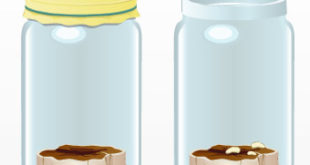Description:Here’s a recipe for a wheat beer I brewed recently. It has a golden orange color and a nice tang to it. Enjoy. 1. I’m finding more and more uses for Cascades! 2. It’s called “cat claw” wheat because of an incident that occurred while brewing. Both the cat and dog (65#shepard) are allowed to watch the brewing process but are not allowed to cross the line from the den into the workshop area. They normally are content to sit side by side and share the dooorway. For some unknown reason (this batch smelled particularly good??), a fight broke out and the dog bought a mean shot from the cat on the nose. I couldn’t call it whining pooch wheat, could I?? 3. Don’t fear the high wheat to pale ratio as far as a stuck mash drain. I had no problem whatsoever and even had to slow the drain rate down so as to not sparge too quickly. (I use a 6′ X 1/2″ slotted coil as my manifold). 4. EXTRACT BASED. I’ve made a good extract based wheat using the same proportion of hops/time schedule and 3.3 #’s of Northwestern Lq. Extract + 4 #’s of light DME (domestic-Red Bank Brewing). | ||
Ingredients:
| ||
| OG: 1.056 FG: 1.015 | ||
Procedure:1. Make a starter with the 3/4 # of DME and 1 gallon of water. Boil down to 3/4 of a gallon and cool with an airlock in place. Pitch a _well puffed_ pack of 3056. Let this go for two days. 2. Preheat the mash chest with a quart or two of boiling water. Empty preheat water and mash in the grains with about 5 gallons of 140 F. to hit a protein rest around 122 F. After about ten minutes, withdraw 4 quarts of liquor from the bottom of the mash, bring to a boil, and add back to the mash. (This was to hold temp., you might not have to). 3. After another ten minutes (20 minutes total protein rest), use about 4-5 gallons of boiling water to hit around 155 F. Hold for 45 minutes. Additional boiling water can be used if necessary, but should be avoided if possible. (I like to hold the extra H20 for sparge if I can). You can also withdraw a gallon at a time, bring to a boil, and return it to the mash (2-3 times max.) to hold temp. (Yes, I know that I’m over the 1 qrt./#grain recommendation…) 4. Sparge right into the kettle using 7 gallons of 175 F. water. Go right to the boil (that’s right, no mashout) and skim off the gray oily foam that comes to the top (subsides after 5-10 minutes). 5. Boil down to 13.5 gallons and add the cascades. Boil for 60 minutes. 6. Turn off heat and add the tettnanger. Let steep for about 15-20 minutes. Run through cooling unit to yield three four- gallon cuts to three 5 gallon fermenters. OG on my last run was 1.056. 7. Pitch 1 qrt. of well mixed starter to each fermenter. Ferment at 70 F. for 2-3 days, until things settle down. Lower temp to 67-68 and ferment for another 11-12 days (total 2 week ferment). I use the brewcap system (except for stouts!) and tap the yeast that settles. Final gravity should be around 1.015 to 1.018. 8. Siphon to keg, chill to 45 F. and C02 at 2.6 volumes (30 psi til it won’t take any more, then go to about 17 psi). 9. Bottle and age for at least three weeks. It’s good off the keg right at day 0 but improves mucho by day 21! | ||
Check Also
Le Budget de la science
par M. L. Pasteur, 1868 Mais quel est donc l’établissement où les laboratoires sont à …
 Pasteur Brewing Louis Pasteur – Science, Health, and Brewing
Pasteur Brewing Louis Pasteur – Science, Health, and Brewing 